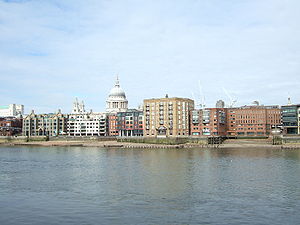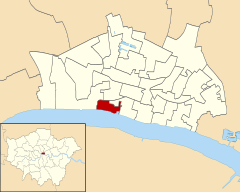Queenhithe
| Ward of Queenhithe | |
|---|---|
 The Queenhithe riverside (upstream to the left; Queenhithe dock on right) from Bankside |
|
 Location within the City |
|
| Ward of Queenhithe shown within Greater London | |
| Population | 319 (2011 Census. Ward) |
| OS grid reference | TQ321808 |
| • Charing Cross | 1.4 miles (2.3 km) West |
| Sui generis | |
| Administrative area | Greater London |
| Region | |
| Country | England |
| Sovereign state | United Kingdom |
| Post town | LONDON |
| Postcode district | EC4 |
| Dialling code | 020 |
| Police | City of London |
| Fire | London |
| Ambulance | London |
| EU Parliament | London |
| UK Parliament | |
| London Assembly | |
Queenhithe is a small and ancient ward of the City of London, situated by the River Thames and to the south of St. Paul's Cathedral. The Millennium Bridge crosses into the City at Queenhithe.
Queenhithe is also the name of the ancient, but now disused, dock and a minor street, which runs along that dock, both of which are within the ward.
The ward is served by London Buses route 388, which runs along Queen Victoria Street and stops by the Millennium footbridge, and the nearest London Underground station is Mansion House, on Queen Victoria Street.
The ward's name derives from the "Queen's Dock", or "Queen's Quay", which was probably a Roman dock (or small harbour), but known in Saxon times as "Aeðereshyð", later "Ethelred's Hythe". The dock existed during the period when the Wessex king, Alfred the Great, re-established the City of London, circa 886 AD. It only became "Queenhithe" (spelt archaically as "Queenhythe") when Matilda, wife of King Henry I, was granted duties on goods landed there. The Queenhithe dock remains today, but has long fallen out of use and is heavily silted up (being tidal). Queenhithe harbour was used for importing corn into London and continued to be in use into the 20th century, by the fur and tanning trades. Being upstream of London Bridge, however, meant that large sea-going sailing ships could no longer safely reach the dock from the sea. King Charles II landed at Queenhithe during the Great Fire of London in September 1666 to view the extent of the destruction and assist in the firefighting.
...
Wikipedia

